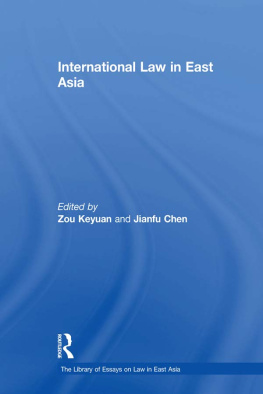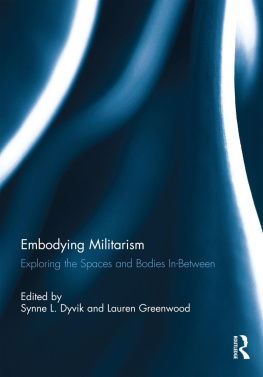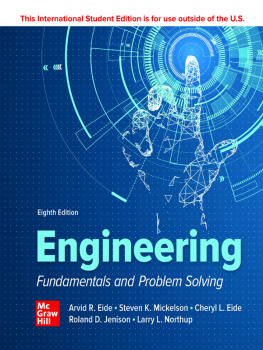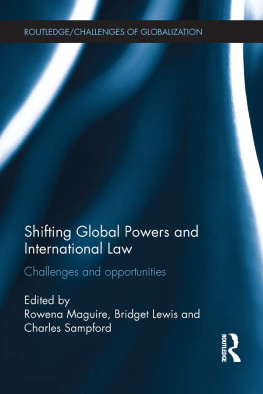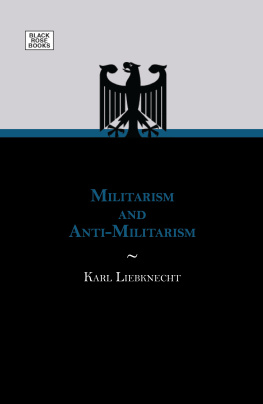ROUTLEDGE LIBRARY EDITIONS:
INTERNATIONAL SECURITY STUDIES
Volume 16
PROBLEMS OF CONTEMPORARY MILITARISM
PROBLEMS OF CONTEMPORARY MILITARISM
Edited by
ASBJRN EIDE
First published in 1980 by Croom Helm Ltd
This edition first published in 2021
by Routledge
2 Park Square, Milton Park, Abingdon, Oxon OX14 4RN
and by Routledge
52 Vanderbilt Avenue, New York, NY 10017
Routledge is an imprint of the Taylor & Francis Group, an informa business
1980 Asbjorn Eide and Marek Thee
All rights reserved. No part of this book may be reprinted or reproduced or utilised in any form or by any electronic, mechanical, or other means, now known or hereafter invented, including photocopying and recording, or in any information storage or retrieval system, without permission in writing from the publishers.
Trademark notice: Product or corporate names may be trademarks or registered trademarks, and are used only for identification and explanation without intent to infringe.
British Library Cataloguing in Publication Data
A catalogue record for this book is available from the British Library
ISBN: 978-0-367-68499-0 (Set)
ISBN: 978-1-00-316169-1 (Set) (ebk)
ISBN: 978-0-367-75244-6 (Volume 16) (hbk)
ISBN: 978-0-367-75247-7 (Volume 16) (pbk)
ISBN: 978-1-00-316165-3 (Volume 16) (ebk)
Publishers Note
The publisher has gone to great lengths to ensure the quality of this reprint but points out that some imperfections in the original copies may be apparent.
Disclaimer
The publisher has made every effort to trace copyright holders and would welcome correspondence from those they have been unable to trace.
Problems of Contemporary Militarism
Edited by
ASBJRN EIDE and MAREK THEE
1980 Asbtyrn Eide and Marek Thee
Croom Helm Ltd, 2-10 St Johns Road, London SW11
British Library Cataloguing in Publication Data
Problems of contemporary militarism.
1. Militarism
2. Military history, Modern - 20th century
I. Eide, Asbjrn II. Thee, Marek
355.023904 U21.2
ISBN 0-7099-0108-9
Typeset by Leaper & Card Ltd, Bristol
Reproduced from copy supplied
printed and bound in Great Britain
by Billing and Sons Limited
Guildford, London, Oxford, Worcester
CONTENTS
Part I: Introduction
Part II: The Global Dimension
2. Militarism: the Issues Today Michael T. Klare
3. The New International Military Order: a Threat to Human Security Jan Qberg
Part III: Meaning of Militarism
4. Militarism, Its Dimensions and Corollaries: an Attempt at Conceptual Clarification Kjell Skjelsbcek
5. Militarism and Underdevelopment Ulrich Albrecht
6. What is Militarism? Ernie Regehr
7. National Security: Propaganda or Legitimate Concern? Robert D. Matthews
8. The Socio-class Determinants of Militarism Ejub KuSuk
9. The Critique of Militarism in Soviet Studies Julian Lider
Part IV: The Military in the Third World
10. Militarism Dynamics in the Contemporary Context of Periphery Capitalism Dieter Senghaas
11. Militarisation and Human Rights in the Third World Richard Falk
12. The Significance of Military Technology Mary H. Kaldor
13. Arms Trade and Transfer of Military Technology to Third World Countries Signe Landgren-Bckstrm
14. Arms Transfers and Dependency in the Third World Miles D. Wolpin
15. Local Wars 1945-76 Istvan Kende
16. The Military Expenditures of Less Developed Nations as a Proportion of their State Budgets: a Research Note Milton Leitenberg and Nicole Ball
Part V: Legal, Social and Cultural Spheres
17. Militarisation with a Global Reach: a Challenge to Sovereignty, Security and the International Legal Order Asbtfrn Eide
18. The Causes and Correlates of Western Militarism William Eckhardt
19. Militarism: Cultural Dimensions of Militarisation Malvern Lumsden
Part VI: Appendices
Appendix 1: World Military Expenditures
Appendix 2: World-wide Military Coups since 1945: a Short Note on Data Collection
Appendix 3: Threats of the Use of Nuclear Weapons since World War II: an Introductory Note
Select Bibliography
Notes on Contributors
PART I
INTRODUCTION
Introduction
Asbjrn Eide and Marek Thee
Militarisation is one of the most conspicuous aspects of contemporary global development. Militarisation manifests itself in the increase in armaments, advances in the destructive capacity of weapons, growing number of people under arms, and dramatic increases in military expenditure. Militaristic attitudes accompany this process of militarisation. The inclination to rely on military means of coercion for the handling of conflicts, which is the most pervasive feature of militaristic attitudes, seems to be gaining ground everywhere.
In 1941, when the world was in turmoil due to aggression unleashed by some highly militarised states, President Roosevelt outlined the values that were to be promoted when the war was over. One of them was the following:
The fourth is freedom from fear - which, translated into world terms, means a world-wide reduction of armaments to such a point and in such a fashion that no nation will be in a position to commit an act of physical aggression against any neighbour anywhere in the world.
Alas, this was not to be. Starting with the very participation in World War II itself, by way of the growth of military production and other military preparations, a qualitative leap into a dynamic process of militarisation had been inaugurated. It was to be quickly accelerated under the impact of the Cold War.
The dramatic increase in the influence of the military was highlighted by President Eisenhower who, in his memorable farewell address, warned against the acquisition of unwarranted influence in the councils of government and state by what he terms the military-industrial complex. As subsequently revealed in many studies, this influence has today a very large socio-political base. It relies on a competitive alliance of vested interests which include not only the military and the military industry, but also the state political bureaucracy interested in using military power as an instrument of diplomacy and politics. Included also is a strong establishment of physical and engineering scientists working for military research and development and planning armaments for years ahead. It is therefore more appropriate to speak now of the military-industrial-technological-bureaucratic complex which favours and stimulates armaments, and serves to enhance the position of the military in national and international life.
The impact of this complex is most strongly felt within the superpowers, East and West. But through military alliances, it also has serious consequences for medium powers and small nations. The military alliances give rise to a bureaucracy of security specialists, and simultaneously there is an increasing integration of armament production. The net effect of this is the formation, on the level of the alliance itself, of an


